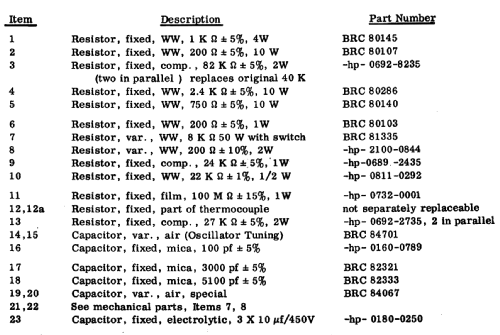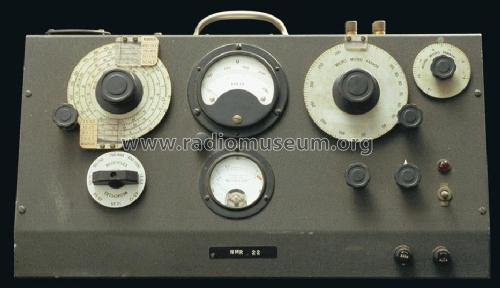Boonton Q-Meter 160-A
Hewlett-Packard, (HP); Palo Alto, CA
- Pays
- Etats-Unis
- Fabricant / Marque
- Hewlett-Packard, (HP); Palo Alto, CA
- Année
- 1959 ??

- Catégorie
- Appareils de mesure et de dépannage (matériel de labo)
- Radiomuseum.org ID
- 82822
Cliquez sur la vignette du schéma pour le demander en tant que document gratuit.
- No. de tubes
- 3
- Lampes / Tubes
- Principe général
- Appareillage spécial ? Renseignements souhaités SVP.
- Gammes d'ondes
- Bandes en notes
- Tension / type courant
- Alimentation Courant Alternatif (CA) / 115 Volt
- Haut-parleur
- - - Pas de sortie basse fréquence
- Matière
- Boitier métallique
- De Radiomuseum.org
- Modèle: Boonton Q-Meter 160-A - Hewlett-Packard, HP; Palo Alto
- Forme
- Modèle de table à panneau incliné
- Remarques
-
The Boonton Q-Meter Type 160-A covers 50 kHz to 75 MHz with the internal oscillator, and 1 kHz to 50 kHz with an external oscillator. With the internal multipliers Qs from 0 to 625 can be measured, and special measurement techniques can measure capacitor Qs as high as 10,000. The basic accuracy is ±5%.
The Boonto Q-Meter has been designed in 1934 and the market introduction was May 1935. According to HP-Information, the instrument was still in production when HP aquired Boonton in 1959, but we believe it was the follower, the 260-A. This HP page puts the Q-Meter Type 160-A to the year 1946 which is definitively wrong. See also Boonton.
Boonton: New Jersey-based Boonton Radio Corporation was founded in 1934 by W. D. Loughlin and several associates and was a manufacturer of electronic test instruments. The new firm concentrated its engineering skill on creating new measuring equipment for the still-young radio industry.
HP acquired Boonton in 1959 as a wholly-owned subsidiary. By then the firm had 150 employees and was a pioneer maker of precision instruments for measuring electrical circuit quality and checking aircraft guidance systems. In a year of phenomenal growth for HP (the company acquired three other firms in 1959), Boonton added to the HP family an old, well-established company with an excellent reputation in a field closely related to many HP products.
The Q-Meter was Boonton's oldest instrument-the first one having been introduced by the company in 1935. It measures the quality factor of coils and other components used in electronic devices and had broad applications in the testing of components and systems.
- Auteur
- Modèle crée par Ernst Erb. Voir les propositions de modification pour les contributeurs supplémentaires.
- D'autres Modèles
-
Vous pourrez trouver sous ce lien 398 modèles d'appareils, 367 avec des images et 139 avec des schémas.
Tous les appareils de Hewlett-Packard, (HP); Palo Alto, CA
Contributions du forum pour ce modèle: Hewlett-Packard, HP;: Boonton Q-Meter 160-A
Discussions: 2 | Publications: 3
I see two version of the same equipment Boonton 160A, one listed under Boonton and the other under Hp.I presume the latter should merge in the former.
Antonio Marra, 18.Sep.16
Dieses Gerät haben wir im Radiolabor Horny auch verwendet.
Zubehör waren einige Induktivitäten mit genau bekanntem Q und bei welcher Frequenz es gilt. Z.B. 203 bei 1 MHz.
Ich habe mich damals über die Schaltung informiert, welches Messprinzip dahintersteckt.
Links in der Schaltung ist ein gewönlicher Oszillator, den man mittels GROB und FINE auf eine Marke auf dem kleinen Instrument einstellen musste. Gemessen wurde das mit dem Thermocouple Unit, in dem sich auch der Einkoppelwiderstand von nur 0,04 Ohm für dem Messschwingkreis mit der unbekannten Spule und dem eingebauten Drehkondensator hoher Güte befindet. Begrenzt wurde die Güte mit dem 100 MOhm Widerstand parallel zum Schwingkreis und dem Einspeisewiderstand von 0,04 Ohm. Natürlich musste der Aufbau der Röhrenumgebung äußerst hochohmig und feuchteabweisend sein.
Vor der Messung bei der gewünschten Frequenz, musste noch auf dem Q-Anzeigeinstrument, das sich in einer Brücke, siehe Schaltung, befand, dieses auf "Null" gestellt werden. Danach stimmte man den Schwingkreis ab und konnte unmittelbar den Q-Faktor ablesen.
Die Gleichrichterschaltung ist ein sogenannter Kathodengleichrichter, der ein phantastischer Spitzenwertgleichrichter ist. Für Detektoren eignet sich das vorzüglich, aber es ist dann kein passiver Detektor mehr, nur nebenbei. Heute mit FET.
Wenn man die Schaltung aus heutiger Sicht betrachtet, fällt auf, wie viele "Nebentätigkeiten" erforderlich waren, ehe man ein Ergebnis hatte. Heutzutage wählt man die Messfrequenz und liest das Ergebnis ab.
Rudolf Drabek, 08.Apr.13




